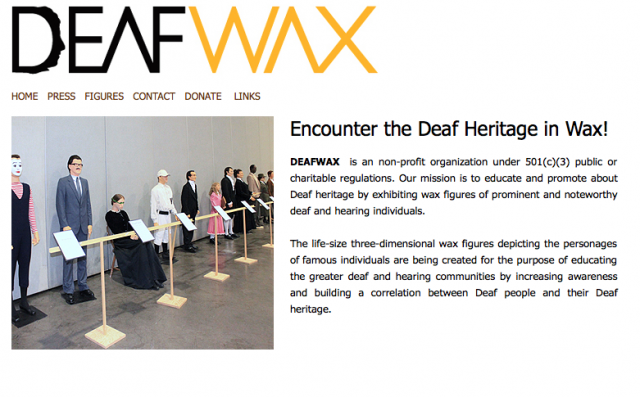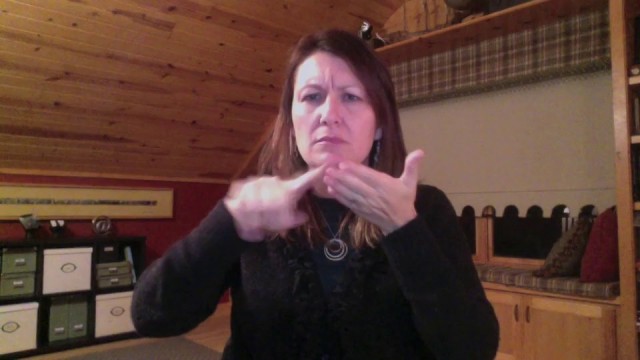Originally appeared in Silent News, February 2002.
Believe it or not, babies born in 1980 – now 22 years old – do not remember a life without captions. But for the rest of us old-timers, we certainly remember life without that funny-looking brown box on top of our TVs that we could buy for $299 (and eventually $99) at Sears. Dynasty still continues to be one of the major events in many deaf people’s lives when talking about favorite shows. It was probably the first show that everyone actually could talk about week after week – who didn’t love to discuss the outlandish outfits, big hair, and hilarious fights between Krystle and Alexis?
It was on March 16, 1980, that the American deaf population tuned in to watch some of the first staples of American television that were closed captioned by the National Captioning Institute (NCI), including The ABC Sunday Night Movie, The Wonderful World of Disney and Masterpiece Theatre. While there were previous attempts to caption shows such as ABC News (which was a re-broadcast shown at 11:30 p.m. Eastern, or at 6:30 a.m the next day.) and The French Chef, which first captioned its shows in 1971 by TheCaption Center, 1980 stands out as the year the captioning took hold in television programming.
It’s been three decades since captioning became reality for television owners and we’ve made great strides. We have an almost a full prime-time captioned line-up, have captioned movies, captioned videotapes and captioned/subtitled DVDs; and captioned lectures. By golly, we’ve arrived!
Not so fast, say many captioning experts.
Hurdles and Obstacles
Jay Feinberg, of NCI in Vienna, Va., says that even though the amount of captioned programming is steadily increasing, there’s still not full access. “Unfortunately, there is no good source of information on exactly how much programming is captioned.” Almost all nationally syndicated programs are captioned, but among cable networks, Feinberg says, captioning levels vary considerably.
A major boost has been the Federal Communications Commission (www.fcc.gov). The Television Decoder Circuitry Act mandated built-in captioning decoders in all television sets 13 inches or larger manufactured after July 1993. Congress also passed a law in 1996 that requires video program distributors to phase in closed captioning of their television programs, although the new law does not require captioning of home videos or video games.
Based on the law passed in 1996, the FCC also requires, as of Jan. 1 this year, that at least 50% of all new network shows be captioned. But many feel the obstacle lies in the fact that there are many exceptions, including programs shown between 2 a.m. and 6 a.m., commercials under five minutes long, programs shown on new networks for the first four years of the network’s operations, and video programming providers with annual gross revenues under $3 million.
“I believe most broadcasters are trying to meet the newest requirements, but there are many exemptions,” says Gary Robson, author of two books on captioning and a developer of captioning software. “For all practical purposes, the laws mandate captioning only on broadcast television.”
Robson’s right. Perhaps the most powerful exemption is the one that exempts home videos. In the “old days” of captioning, deaf people would often check the covers of rental videos carefully to see if they were captioned or not. Nowadays, that’s a rare occurrence.
Even so, Bill Stark, project director of the Captioned Media Program, reminds us that there’s still a huge gap between full accessibility and where we are today. “You probably are accustomed to going to a video store and finding most current movies with closed captions. But if you were a teacher of deaf kids and looking for captioned videos, you’d find that under 20% have captions,” he says.
“If you were a parent of a deaf kid and looking for educational captioned CD-ROMs or educational captioned DVDs, or captioned anything, you’d be very frustrated.”
Kelby Brick, a deaf attorney in Laurel, Md., filed a complaint with the FCC against cable company provider Comcast and Court TV for not meeting the Jan. 1 , 2000, requirement of having 25% of its programming captioned. FCC ruled in Brick’s favor, noting that Court TV had voluntarily, as a result of Brick’s complaint, increased the hours of captioning on its network.
These aren’t the only obstacles preventing us from full access to our society. Joe Clark, the Ralph Nader of the captioning industry and considered by many one of the captioning industry’s pests, says that quality of captioning is a serious concern.
“No, quite obviously, we are not at ‘full access yet’,” Clark, an author and accessibility consultant based in Toronto, says. “We would need something approaching 90% captioning on all programming that could be captioned to achieve ‘full access.’ I say 90%, because, as in the Canadian regulations, if you’re captioning 90% you’re probably captioning 100%, and in any event some unavoidable technical problem will come up on a rare occasion.
“Unfortunately, though, quality of captioning, which was never great, has gone steadily downhill…Mom-and-pop captioning shops and postproduction houses who seem to think that captioning is ‘straightforward’ are a pox on the industry.”
He claims that a reason for this is the captioners’ salaries. “Salaries are crap… Moreover, it’s an insult. You’re supposed to be a university graduate with unmatched literacy, and temp secretaries earn more money than you do? Frankly, you might as well work as a phone-sex operator. It’ll earn you a lot more money than captioning.”
Although Clark’s view is a bit extreme, many real-time captioners also work at meetings needing computer-assisted real-time captioning (CART), or in court situations. The equipment basics are the same – and requirements, though for different needs, are basically the same. Many real-time captioners work on a free-lance basis, working for anyone who wants to use CART, with minimal training.
Even so, there are real-time captioning companies that genuinely do provide top-notch, quality services. One such company is Caption First, located in Chicago. Pat Graves, president, says that the company has 12 real-time captioners working for the company who are predominantly certified real-time reporters. The certification is awarded by the National Court Reporters Association (NCRA). Graves is also the chairperson of the NCRA CART Task Force, which “has written a manual and guidelines for professional practice pertaining to CART,” she says.
Brenda Breaux, a real-time captioner in New Orleans who attended college specializing in court reporting, says that she had to pass speed tests starting at 60 words per minute and going as high as 225 words per minute. “I had to pass three tests in three categories – literary, jury charge, and testimony – with 97 percent accuracy. ” She specializes in court reporting and classroom captioning for deaf and hard of hearing students (and also blind students, who have their transcripts transcribed into Braille by the colleges).
“Training for CART providers and TV news captioners requires familiarity and programming of words, or dictionaries, pertaining to each individual job, assignment or news program. The goal is to have 100 percent translation and accuracy, and that comes with an internship and training period,” Graves explains in an e-mail. “We do not allow CART providers and captioners to ‘practice’ on consumers!”
Even with these stringent training requirements, Clark still thinks it’s not enough. Clark has spent decades writing to captioning companies notifying them of captioning errors. Indeed, captioning bloopers are sometimes funny, but mostly they are confusing, especially in times of emergency live newscasts when new vocabulary (the September 11 attacks, for example) may be introduced for the first time to the viewing audience.
He says that often, when tapes are re-encoded (captions being redone to an original, pre-recorded tape) the error is supposedly fixed. “But in practice, even re-encoded tapes – like syndicated episodes of The Simpsons – contain the original errors.” So, Clark says, when a captioner is notified of an error, the captioner should eat the cost of re-encoding the program.
“Now, can you imagine how well that would go over? Captioners would suddenly become accountable, and their errors would suddenly begin to cost them. And I mean, we can’t have that! Not when we’re paying our caption ‘editors’ $20,000 a year!”
Robson thinks another obstacle in achieving full caption accessibility is education. “Despite the huge amount of information about captioning that’s been published, far too many people in the broadcast business don’t understand the fundamentals. Why are they captioning in the first place? What are the captions supposed to accomplish?”
NCI’s Feinberg adds, “The reasons for captioning are complex – a combination of doing the right thing, meeting mandates and technical sophistication. A major effort in the early days of captioning was to make network executives aware of how important it was to people who are deaf and hard of hearing to be able to have the same access to the wide range of entertainment and important news programming on television that hearing people had. Even as awareness increased, budgets were slow to follow.” He credits the U.S. Department of Education funding as being a major boost to the hours of captioned programming available.
The Next Decade
So, in the next decade, what should we expect? Feinberg says most of the changes to come will be invisible to the regular viewer. “Technically, the biggest change will be the conversion to digital television… the current plans for captioning digital television will give viewers control over the appearance of the captions on the screen, such as size, color, and font.” He also believes that continuing advances in computer technology will help captioners provide high-quality captions at lower costs.
Robson, whose wife is a real-time captioner, predicts that captioning will become commonplace. “Ten years from now, it will be difficult to find a person who doesn’t know what captioning is and how to [activate] it on their television set.”
Clark, however, is a bit more pessimistic. “[Captioning] will get worse. More widespread, but worse.”
Perhaps, as has been the case for many years now, most of us will simply continue to discover new captioned shows exactly how Gallaudet University President I. King Jordan did: by surprise.
In the early 1990s, Jordan attended a meeting of the Caption Center advisory board in Boston during the day and then flew home to hurry and attend a black- tie event in the evening in Washington, D.C.
“I can remember rushing into my bedroom to change into a tux and having the TV on while I was dressing. It was turned to the local NBC affiliate and the local news was on,” Jordan recalls. “I was standing there watching and following the news when all of a sudden it hit me. Hey, I can understand this! A local news program was captioned! Live!”
Prior to that, only the national news broadcasts were captioned in the District. Jordan continues, “I was blown away because they hadn’t made a big deal about it, it just appeared. It took years before all the local news was captioned, but now ABC, CBS, NBC and FOX are all captioned live. I think news and, more importantly, emergency coverage captioning is most important, and we have come a long way.”
Special thanks to David Pierce for his technical assistance.
Copyrighted material. This article can not be copied, reproduced, or redistributed without the written consent of the author.


